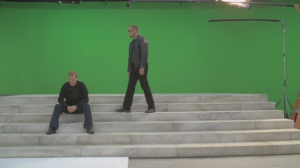Mind-Blowing Green Screen TV and Film Effects – And How To Do Them Yourself
“You’ve gotta see it to believe it” means less and less as we take each step into a digitally manipulatable future that is nearly impossible to distinguish from the real thing.
Need to film a visit to Vegas? NYC? Moscow? Green screen it! As evidenced by the above demo reel, we’re now at a point where the television and movie images that look and feel so very real are as fake as science fiction. Even as someone who works in the entertainment industry, I’m blown away, and maybe even saddened a little by these illusions be revealed to me – I truly thought Hiro from Heroes was IN Times Square. But it is a testament to the acting abilities and the special effects capabilities that we have available today.








So how can you, the aspiring filmmaker, do something similar? It’s become easier and more accessible then ever before. Using a technique called chroma keying, a preset color area is replaced (using basic video software) with a separate image feed. Usually the color to be replaced is green or blue, because those are the colors furthest from the human skin tone.
The main components you’ll need:
-A large green surface to film in front of. You can either use green backdrops (surprisingly affordable, especially if you already have a mounting setup), or chroma key green paint. Just remember to get something big enough that you can fit the whole scene onto it, including the ground area if that is to be replaced as well. You can see in some of the video examples that they occasionally paint the entire room green, floor to ceiling.
– Smooth even lighting: Avoiding casting shadows onto the green screen is pretty important to getting a good result when doing the video replacement.
– The necessary hardware to capture and process the footage. A camera and computer with software as simple as iMovie is capable of doing this. Even iChat has a rudimentary function that can process this pretty well too.
Film the action in front of/around the green screened area. Film corresponding footage to be chroma keyed into place. Then use your editing software to merge the images into one awesome, hilarious output.
Here’s an example that my acquaintance John Irwin did for my friends’ band, Meanest Man Contest‘s new music video, simulating a wild driving sequence. Sitting in a car with greened-out windows, the band and friends sway from side to side as the camera films them. High-speed, swerving driving footage replaces the windows and BAM, instant action.
Watch the finished video here.
Of course, working on projects the scale of network shows and feature films require materials and hardware that are a few steps past what most people have available to them. But each innovation in technology makes these things one step closer than before. Its up to you to get up and find it, learn it, and make it happen.
